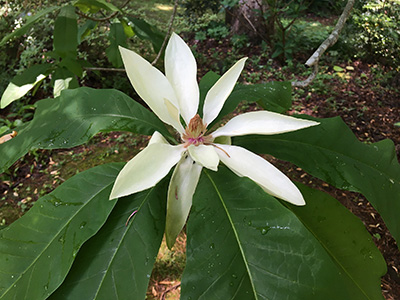Magnolias

Umbrella magnolia (Magnolia tripetala) is only found in Florida in the Panhandle and is endangered. Photo: Scott Zona.
The Southern magnolia is perhaps the most well-known magnolia in Florida. However, there are many other magnolias that are native to our area, so you should have no trouble finding one that's right for your landscape.
The magnolia family is a group of about eighty species of trees and large shrubs, which are best suited to North and Central Florida. Magnolia flowers do not produce true nectar, but attract pollinating beetles with fragrant, sugary secretions. Magnolias can be divided into two groups: those that lose their leaves and those that stay evergreen.
All magnolias grow best in moist, well-drained, slightly acid soils, with morning sun and shade in the afternoon. The primary pest of all Magnolia species is magnolia scale (Neolecanium cornuparvum).
Besides the stately Southern magnolia, there's the deciduous saucer magnolia, which flowers in spring before sprouting new leaves. The sweetbay magnolia has leaves with a silvery underside, and creamy white, lemon-scented flowers that are smaller than the Southern magnolia's.
There are several new evergreen magnolias being introduced from Asia, with unusual flower and foliage colors. Some have pink or even red flowers, while several species have buds, leaves, or stems covered with soft hairs in colors ranging from deep brown to rust to bright copper.
Also on Gardening Solutions
- Fragrance Gardens
- Moonlight Gardens
- Saucer Magnolia
- Southern Magnolia
- Star Magnolia
- Sweetbay Magnolia

